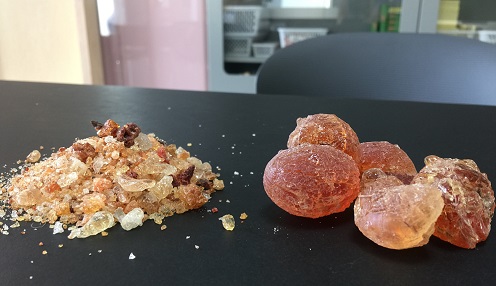The use of near-infrared spectroscopy is gaining momentum in the food industry
The use of near-infrared spectroscopy (NIRS) in the food industry has gained momentum, estimates a researcher from the University of Copenhagen. The reason is that the method is incredibly effective for quality testing of raw materials, ingredients and finished products – and as a tool to detect food fraud.

Example of near-infrared spectra of a food ingredient. The two curves show two different kinds of gum arabic of a high respectively low quality. The two lines show how the samples absorb light at different wavelengths and, if you are studying how the curves process in more detail, you can see that they deviate slightly from each other in form in some places. It is these small differences that you use to determine the quality with the help of multivariate data processing (chemometrics). With chemometrics, even variations in the spectra that cannot be seen in a plot with the naked eye can be isolated and be made into very robust and precise quality parameters.
The major advantage of using near-infrared spectroscopy for quality testing of raw materials and products is that it is fast and can be used on many different kinds of foods.
"We call it a rapid method, and it can be used on almost all kinds of food: powder, liquids, gels, solids, etc. It is a non-destructive method, as you are using the light to examine the quality, as opposed to conventional methods, where you are using chemistry," says Klavs Martin Sorensen, postdoc at the Department of Food Science (FOOD), University of Copenhagen.
The speed and ease with which the method can be used gives companies the opportunity to control and manage the quality of raw materials, semi-finished products or the final product much more frequently than when using conventional analyses.
“Analyses with NIRS also gives the company an opportunity to achieve more uniform quality and to use the analytical data as support when selecting suppliers that comply with the company's quality requirements. At the other end of production, you can check that products live up to what you promised customers," says Klavs Martin Sorensen.
By using NIRS you can also measure several characteristics of the food item at once. In a milk powder, for instance, you will at the same time be able to establish the contents of protein, fat and water. The measurement itself is carried out by taking a sample of the food and placing it in a sample cup. The cup is placed in the spectrometer, after which the actual analysis typically takes less than a minute, and you have the result immediately. The method is non-destructive, and you would in principle be able to return the sample to production after measurement has finished.
"The individual parameters are measured on the basis of the measured optical spectrum, which are interpreted with advanced data analysis (see fact box, ed.). The spectrometer has been calibrated to be able to determine the quality parameters by means of mathematical models that are defined in relation to the food and the properties to be examined. The user is not required to know about the spectra or near-infrared light, as virtually all instruments merely present the measured quality characteristics. You can have a whole library of parameters that can be measured, if you want," says Klavs Martin Sorensen.

Postdoc at FOOD Klavs Martin Sorensen. Picture: Daniel Schultz Madsen
NIRS used for Process Analytical Technology (PAT)
Near-infrared spectroscopy is also one of the most important tools in Process Analytical Technology (PAT). PAT is defined by the US Food & Drug Administration (FDA) and is a product principle with very strong quality monitoring, designed for the pharmaceutical industry. The method is also popular in the food industry and involves continual online control of all raw materials delivered to the production process, and of all the finished products.
Laboratory-based NIRS is done by placing the food material in a sample cup and inserting it in the spectrometer, whereas PAT makes it possible to check the quality of all raw materials/semi-finished goods/products regularly, while production is in progress.
"As we are talking about near-infrared light, you can use optical fibres to move it around and by means of an optical probe measure directly in the production flow. This way you can determine the quality parameters and have a 100% effective inspection of the process. There are NIRS probes developed with special regard for hygiene and safety requirements, which can be introduced into the product streams in the same way as other process instruments, for example pressure gauges and thermometers," says Klavs Martin Sorensen.
The use of PAT means that the company will very quickly discover if something’s wrong, and thus are also able quickly to intervene. Apart from improved quality, the use of PAT also minimises waste of both raw materials and finished products.
NIRS is a good tool for detection of suspected food fraud
NIRS has become an attractive tool for quickly and efficiently revealing food fraud. Just like the mathematical models that can be used to determine the quality parameters in the food items, you can develop models that can evaluate whether a food is "pure" or contaminated with irrelevant substances.

To the right is gum arabic of a high quality in the form of “tears” from the acacia tree Acacia Senegal, which has been difficult to obtain at times because of conflicts in the growing areas. To the left is gum arabic of a much lower and more impure quality from the tree Acacia Seyal. Gum arabic is used in Ga-Jol, where it provides the unique chewing and flavour-release sensation. Picture: Lene Hundborg Koss.
"Even though NIRS is widely used in the food industry, it can be used far more. The instruments, in line with technological development, are getting cheaper, it will become more attractive to use NIRS at production sites, where you previously wouldn’t have been using advanced measuring equipment," says Klavs Martin Sorensen.
He is co-author of a scientific article about the use of NIRS to detect food fraud, which is published in Current Opinion in Food Science (see fact box).
This article is also published in the December issue 2016 by the Danish magazine Plus Process.
Topics
Related News
Contact
Postdoc Klavs Martin Sorensen, kms@food.ku.dk
or
Journalist Lene Hundborg Koss, lene.h.koss@food.ku.dk
NIRS conference in Copenhagen
The Department of Food Science (FOOD) at the University of Copenhagen is hosting the 18th conference on near-infrared spectroscopy, entitled "NIRS at work in industry”, which will be held at Bella Sky in Copenhagen from 11 to 15 June 2017. Over 400 delegates are expected to attend, and FOOD has organised courses for both industry and students in e.g. calibration, sampling and Process Analytical Technology (PAT).
Scientific paper
The article “The use of rapid spectroscopic screening methods to detect adulteration of food raw materials and ingredients” has been published as an expert opinion in the scientific journal Current Opinion in Food Science (http://dx.doi.org/10.1016/j.cofs.2016.08.001)
The authors from the Department of Food Science at the University of Copenhagen are: Postdoc Klavs Martin Sørensen, postdoc Bekzod Khakimov, and Professor Søren Balling Engelsen.
Facts about NIRS
Light is energy with different wavelengths, which is crucial for the colour. Red light has one wavelength, blue light another. The near-infrared light lies outside the area we can see. But you can visualise it by means of a colour spectrum, i.e. the colour curve, which occurs when you look at the intensity of the different wavelengths or colours that the light contains. The chemical composition of a food, raw material or an ingredient is essential for how the different wavelengths of light interacts with the active ingredients in the material. Therefore, you can, via a near-infrared spectrometer, get a "fingerprint" of the physicochemical information that is unique to the food material and can be used to determine the quality.
